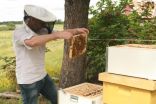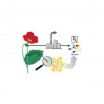(Press-News.org) Exercising to improve our cardiovascular strength may protect us from cognitive impairment as we age, according to a new study by researchers at the University of Montreal and its affiliated Institut universitaire de gératrie de Montréal Research Centre. "Our body's arteries stiffen with age, and the vessel hardening is believed to begin in the aorta, the main vessel coming out of the heart, before reaching the brain. Indeed, the hardening may contribute to cognitive changes that occur during a similar time frame," explained Claudine Gauthier, first author of the study. "We found that older adults whose aortas were in a better condition and who had greater aerobic fitness performed better on a cognitive test. We therefore think that the preservation of vessel elasticity may be one of the mechanisms that enables exercise to slow cognitive aging."
The researchers worked with 31 young people between the ages of 18 and 30 and 54 older participants aged between 55 and 75. This enabled the team to compare the older participants within their peer group and against the younger group who obviously have not begun the aging processes in question. None of the participants had physical or mental health issues that might influence the study outcome. Their fitness was tested by exhausting the participants on a workout machine and determining their maximum oxygen intake over a 30 second period. Their cognitive abilities were assessed with the Stroop task. The Stroop task is a scientifically validated test that involves asking someone to identify the ink colour of a colour word that is printed in a different colour
(e.g. the word red could be printed in blue ink and the correct answer would be blue). A person who is able to correctly name the colour of the word without being distracted by the reflex to read it has greater cognitive agility.
The participants undertook three MRI scans: one to evaluate the blood flow to the brain, one to measure their brain activity as they performed the Stroop task, and one to actually look at the physical state of their aorta. The researchers were interested in the brain's blood flow, as poorer cardiovascular health is associated with a faster pulse wave,at each heartbeat which in turn could cause damage to the brain's smaller blood vessels. "This is first study to use MRI to examine participants in this way," Gauthier said. "It enabled us to find even subtle effects in this healthy population, which suggests that other researchers could adapt our test to study vascular-cognitive associations within less healthy and clinical populations."
The results demonstrated age-related declines in executive function, aortic elasticity and cardiorespiratory fitness, a link between vascular health and brain function, and a positive association between aerobic fitness and brain function. "The link between fitness and brain function may be mediated through preserved cerebrovascular reactivity in periventricular watershed areas that are also associated with cardiorespiratory fitness," Gauthier said. "Although the impact of fitness on cerebral vasculature may however involve other, more complex mechanisms, overall these results support the hypothesis that lifestyle helps maintain the elasticity of arteries, thereby preventing downstream cerebrovascular damage and resulting in preserved cognitive abilities in later life."
INFORMATION:
About this Study
This work was supported by the Canadian Institutes for Health Research (MOP 84378, Banting and Best Scholarship held by CJG, Canadian Research Chair to LB), the Canadian Foundation for Innovation (Leaders Opportunity Fund 17380), the Ministère du développement économique, de l'innovation et de l'exportation (PSR-SIIRI-239) and the Canadian National Sciences and Engineering Research Council (R0018142). The findings were published in Neurobiology of Aging on August 20, 2014. The University of Montreal is officially known as Université de Montréal.
Train your heart to protect your mind
New study links cardiovascular health to cognitive changes as we age
2014-08-25
ELSE PRESS RELEASES FROM THIS DATE:
Study suggests repurposing anti-depressant medication to target medulloblastoma
2014-08-24
CINCINNATI – An international research team reports in Nature Medicine a novel molecular pathway that causes an aggressive form of medulloblastoma, and suggests repurposing an anti-depressant medication to target the new pathway may help combat one of the most common brain cancers in children.
The multi-institutional group, led by scientists at Cancer and Blood Diseases Institute (CBDI) at Cincinnati Children's Hospital Medical Center, publish their results in the journal's online edition on Aug. 24. The researchers suggest their laboratory findings in mouse models of ...
Evolutionary history of honeybees revealed by genomics
2014-08-24
In a study published in Nature Genetics, researchers from Uppsala University present the first global analysis of genome variation in honeybees. The findings show a surprisingly high level of genetic diversity in honeybees, and indicate that the species most probably originates from Asia, and not from Africa as previously thought.
The honeybee (Apis mellifera) is of crucial importance for humanity. One third of our food is dependent on the pollination of fruits, nuts and vegetables by bees and other insects. Extensive losses of honeybee colonies in recent years are a ...
Signatures of selection inscribed on poplar genomes
2014-08-24
One aspect of the climate change models researchers have been developing looks at how plant ranges might shift, and how factors such as temperature, water availability, and light levels might come into play. Forests creeping steadily north and becoming established in the thawing Arctic is just one of the predicted effects of rising global temperatures.
A recent study published online August 24, 2014 in Nature Genetics offers a more in-depth, population-based approach to identifying such mechanisms for adaptation, and describes a method that could be harnessed for developing ...
Mimicking natural evolution with 'promiscuous reactions' to improve the diversity of drugs
2014-08-24
A revolutionary new scientific method developed at the University of Leeds will improve the diversity of 'biologically active molecules', such as antibiotics and anti-cancer agents.
The researchers, who report their findings online today in the journal Nature Chemistry, took their inspiration from evolution in nature. The research may uncover new pharmaceutical drugs that traditional methods would never have found.
"Nature produces some amazing structures with really interesting biological activity, but the plant or animal did not design them. Instead the organisms ...
Study: Cutting emissions pays for itself
2014-08-24
CAMBRIDGE, Mass-- Lower rates of asthma and other health problems are frequently cited as benefits of policies aimed at cutting carbon emissions from sources like power plants and vehicles, because these policies also lead to reductions in other harmful types of air pollution.
But just how large are the health benefits of cleaner air in comparison to the costs of reducing carbon emissions? MIT researchers looked at three policies achieving the same reductions in the U.S., and found that the savings on health care spending and other costs related to illness can be big ...
Driving brain rhythm makes mice more sensitive to touch
2014-08-24
PROVIDENCE, R.I. [Brown University] — By striking up the right rhythm in the right brain region at the right time, Brown University neuroscientists report in Nature Neuroscience that they managed to endow mice with greater touch sensitivity than other mice, making hard-to-perceive vibrations suddenly more vivid to them.
The findings offer the first direct evidence that "gamma" brainwaves in the cortex affect perception and attention. With only correlations and associations as evidence before, neuroscientists have argued for years about whether gamma has an important role ...
Are you as old as what you eat? Researchers learn how to rejuvenate aging immune cells
2014-08-24
Researchers from UCL (University College London) have demonstrated how an interplay between nutrition, metabolism and immunity is involved in the process of ageing.
The two new studies, supported by the Biotechnology and Biological Sciences Research Council (BBSRC), could help to enhance our immunity to disease through dietary intervention and help make existing immune system therapies more effective.
As we age our immune systems decline. Older people suffer from increased incidence and severity of both infections and cancer. In addition, vaccination becomes less efficient ...
Stanford bioengineers close to brewing opioid painkillers without using opium from poppies
2014-08-24
For centuries poppy plants have been grown to provide opium, the compound from which morphine and other important medicines such as oxycodone are derived.
Now bioengineers at Stanford have hacked the DNA of yeast, reprograming these simple cells to make opioid-based medicines via a sophisticated extension of the basic brewing process that makes beer.
Led by Associate Professor of Bioengineering Christina Smolke, the Stanford team has already spent a decade genetically engineering yeast cells to reproduce the biochemistry of poppies with the ultimate goal of producing ...
'Haven't my neurons seen this before?'
2014-08-24
PITTSBURGH—The world grows increasingly more chaotic year after year, and our brains are constantly bombarded with images. A new study from Center for the Neural Basis of Cognition (CNBC), a joint project between Carnegie Mellon University and the University of Pittsburgh, reveals how neurons in the part of the brain responsible for recognizing objects respond to being shown a barrage of images. The study is published online by Nature Neuroscience.
The CNBC researchers showed animal subjects a rapid succession of images, some that were new, and some that the subjects ...
Neuroscience and big data: How to find simplicity in the brain
2014-08-24
PITTSBURGH—Scientists can now monitor and record the activity of hundreds of neurons concurrently in the brain, and ongoing technology developments promise to increase this number manyfold. However, simply recording the neural activity does not automatically lead to a clearer understanding of how the brain works.
In a new review paper published in Nature Neuroscience, Carnegie Mellon University's Byron M. Yu and Columbia University's John P. Cunningham describe the scientific motivations for studying the activity of many neurons together, along with a class of machine ...
LAST 30 PRESS RELEASES:
Revealing the diversity of olfactory receptors in hagfish and its implications for early vertebrate evolution
Development of an ultrasonic sensor capable of cuffless, non-invasive blood pressure measurement
Longer treatment with medications for opioid use disorder is associated with greater probability of survival
Strategy over morality can help conservation campaigns reduce ivory demand, research shows
Rising temperatures reshape microbial carbon cycling during animal carcass decomposition in water
Achieving ultra-low-power explosive jumps via locust bio-hybrid muscle actuators
Plant-derived phenolic acids revive the power of tetracycline against drug-resistant bacteria
Cooperation: A costly affair in bacterial social behaviour?
Viruses in wastewater: Silent drivers of pollution removal and antibiotic resistance
Sub-iethal water disinfection may accelerate the spread of antibiotic resistance
Three in four new Australian moms struggle with body image
Post-stroke injection protects the brain in preclinical study
Cardiovascular risk score predicts multiple eye diseases
Health: estimated one in ten British adults used or interested in GLP-1 medications for weight loss
Exercise to treat depression yields similar results to therapy
Whooping cough vaccination for pregnant women strengthens babies’ immune system
Dramatic decline in new cases of orphanhood in Uganda driven by HIV treatment and prevention programs
Stopping weight loss drugs linked to weight regain and reversal of heart health markers
Higher intake of food preservatives linked to increased cancer risk
Mass General Brigham–developed cholera vaccine completes phase 1 trial
First experimental validation of a “150-year-old chemical common sense” direct visualization of the molecular structural changes in the ultrafast anthracene [4+4] photocycloaddition reaction
Lack of support for people on weight loss drugs leaves them vulnerable to nutritional deficiencies, say experts
Dogs’ dinners can have greater climate impact than owners’
Are you ready to swap salmon for sprats and sardines?
1.6 million UK adults used weight loss drugs in past year
American College of Cardiology comments on new dietary guidelines for Americans
American Society of Gene & Cell Therapy and Orphan Therapeutics Accelerator partner to advance and commercialize promising rare disease treatments
One in 14 patients having day case surgery have new or worse chronic pain 3 months after their operation
New study highlights link between eviction rates and gun violence
Heatwaves heat up soil but not toxin levels in rice, study finds
[Press-News.org] Train your heart to protect your mindNew study links cardiovascular health to cognitive changes as we age



